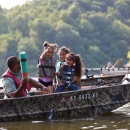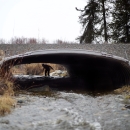States
OhioThe Great Miami River Watershed Barrier Removal and Habitat Restoration project represents a collective effort by communities inspired by the Great Miami Riverway, to integrate ecological benefits with local economic and recreational investments. U.S. Fish and Wildlife Service, Environmental Protection Agency, and Ohio’s State Revolving Loan Fund-supported Water Resource Restoration Sponsor Program combined investments will remove three low-head dams, re-connect a 1.5-mile-long oxbow channel, restore this segment of the river to Exceptional Warmwater Habitat status, and create a bank-to-bank nature-like fishway. Immediate improvements will also protect access to and quality of the City of Piqua’s drinking water with expected improvements in neighboring communities as the project continues. The Great Miami River is one of only 35 National Water Trail systems nationally and the only one in Ohio. When completed, this project will enhance safety of and access to the existing water trail, offering greater recreational opportunities. The removal of hazardous structures within the system is critical, as they have been linked to multiple fatalities. Addressing these dangers will make the Great Miami River National Water Trail safer for everyone.
Project Quick Facts:
- Location: Ohio
- Federal Investments to Date: $3,600,000
- Non-Federal Investments to Date: $10,000,000
- Total Restoration Costs: $50,000,000+
- Type of Barriers: Low-Head Dam
- Number of Barriers: 24
- Stream Miles Reopened: 1000+
- Acres Restored: 500+
- Project Leads: U.S. Fish and Wildlife Service, Ohio Environmental Protection Agency, Miami Conservancy District
- Non-Federal Partners Include: State of Ohio, Toledo Zoo, Cities of Troy, Piqua, Covington, and Sidney, Miami Valley Regional Planning Commission
- Federal Agencies Invested to Date: U.S. Fish and Wildlife Service, Environmental Protection Agency, U.S. Army Corps of Engineers
Removing Barriers to Success
This project is part of a larger initiative to restore fish habitat, improve municipal needs such as drinking water supply systems and recreational activities in the Great Miami River Basin. With additional funding, continued collaboration and community support, this project seeks to eliminate up to 24 instream barriers spread across the Great Miami River Basin, reducing safety risks for water users, improving water quality and aquatic ecosystem health, and bringing us closer to achieving a basin-wide transformation.
The Importance of Transformational Fish Passage Projects
This project is one of over 70 grand-scale, community-centric restoration projects, identified by the Federal Interagency Fish Passage Task Force, that not only rejuvenate ecosystems but also bolster the climate resilience and economies of communities across the country. Learn more about these ground breaking projects in our Reviving Rivers, Reconnecting Communities story map.
The National Fish Passage Program combines technical expertise with a track record of success.
Implemented primarily through the Service's Fish and Wildlife Conservation Offices, the National Fish Passage Program provides financial and technical assistance to partners across the country. Since 1999, the program has worked with over 2,000 local communities, Tribes, and private landowners to remove or bypass over 3,400 barriers to fish passage fish passage
Fish passage is the ability of fish or other aquatic species to move freely throughout their life to find food, reproduce, and complete their natural migration cycles. Millions of barriers to fish passage across the country are fragmenting habitat and leading to species declines. The U.S. Fish and Wildlife Service's National Fish Passage Program is working to reconnect watersheds to benefit both wildlife and people.
Learn more about fish passage and reopen access to over 61,000 miles of upstream habitat for fish and other animals. Staff have expertise in fish migration and biology as well as financial, engineering, and planning assistance to communities, Tribes, and landowners to help them remove barriers and restore rivers for the benefit both fish and people.
Fish passage project proposals can be initiated by any individual, organization, government, or agency. However, proposals must be submitted and completed in cooperation with a Fish and Wildlife Conservation Office. (Please note that fish passage projects being used for federal or state compensatory mitigation or required by existing federal or state regulatory programs are not eligible for funding through the National Fish Passage Program.)
CONTACT A FISH PASSAGE COORDINATOR IN YOUR AREA TO GET STARTED.


